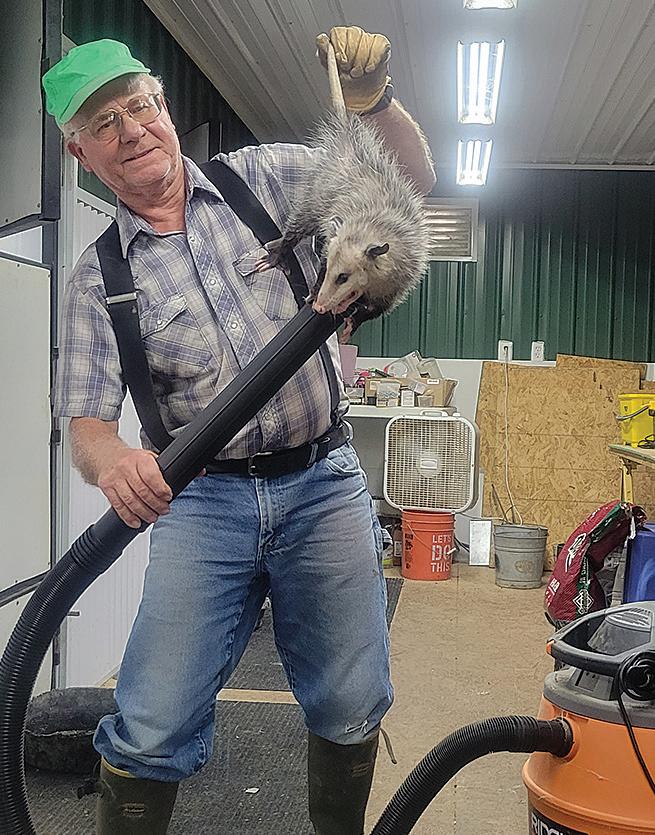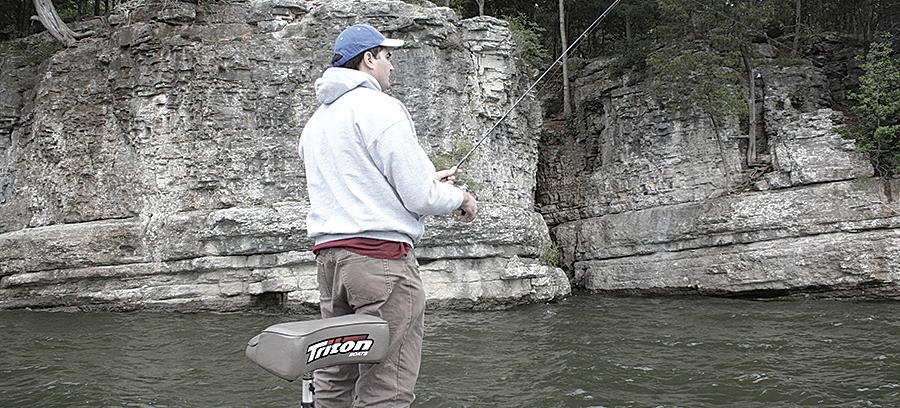
11 minute read
When vermin call
Applying negative pressure when vermin come to call
Photos and Text By RANDALL P. DAVIS
The lady’s voice dripped with frantic distress through the cell phone.
“There’s a huge rat inside my puppy kennel,” she said. “I’ve beaten it away with a mop, but it ran under one of the kennel floors.I can see its nasty face, but the mop handle ain’t long enough to reach it!
“I know if I don’t stay here, it’s going to come out and eat up one of my prized Peekapoos! I need your help, NOW!”
I told the client I was 30 minutes away and to remain on guard until I arrived. I’ve found that if I give clients small homework assignments, such as monitoring cage traps or keeping a visual on the varmint until I get there, they feel helpful and will do their duty to the letter.
I don’t like rats. They carry and spread more diseases than nearly any other animal.So when I have the call to eliminate such vermin, I don’t hesitate.But on this call, I had my suspicions. Rats aren’t that way. They’re communal. You’ll see several, not just one.I just didn’t think I’d find a Peekapoo playing peek-aboo with a large rat-a-roo!
THE MONSTER LIES IN WAIT
When I arrived, the lady vigorously waved me into the whelping building and directed me to a side pen. Here the floor was slightly elevated and covered with plastic grating to allow the puppy’s waste to fall through and permit the miniature mutts to remain clean. She pointed to the area where, as she stated, “that massive animal lies in wait.”
I was able to get on my belly and saw a small 8” by 12” opening that accessed another recess, which went well beyond reach of her mop and my grabbing tongs or catch pole.
I probed the interior with my flashlight and confirmed my suspicion. The lady’s 10-pound New York sewer rat was actually a young, twopound possum, likely preying on puppy kibble.
The varmint was more possum than vermin. Where there’s a Shop-vac, there’s a way!

‘IT’S GONNA SUCK!’
I contemplated my options. I could disassemble the plastic flooring above the possum, and if the critter remained after all the commotion, snatch it with my tongs. Or, I could locate a length of PVC pipe, fabricate a noose on one end as a catch pole, then wiggle on my belly through puppy poop to get closer to the tiny opening and perhaps reach way back to snare the small trespasser.All I could think was, “Either way, this is gonna suck!”
Then it hit me. I WOULD make this job suck! I remembered seeing a large wet/ dry shop-vac just inside the whelping building.I asked the lady if I could borrow it for a few minutes.
Her eyes widened as she broke into a smile. “You think this will really work?” she asked.
“Ma’am,” I said, “I think we’re about to make history.”
While assembling the 3-inch nozzle and hose, I remembered my high school freshman science teacher once saying, “A vacuum is nothing more than a negative pressure below atmospheric pressure.With a strong enough vacuum, one could lift an elephant.”
All I wanted was enough suction to pluck a petrified possum.
LIKE PLAYING A CARP
With the rig in place, I focused the light on the marsupial, then snaked the tube back into the recess. Once the end was a few inches from my target, I called for the lady to flip the switch.
Immediately the suction pulled the possum’s front leg into the nozzle up to the shoulder. The once sullen creature was now vigorously trying to overcome the effects of negative pressure and negative traction on a slick, concrete floor. It was like playing a carp in shallow water.
Within seconds I had the possum pulled from the recess and a firm grip on its tail. It was then quickly ushered into an awaiting cage. Job done!
The lady was greatly relieved – and a bit embarrassed that the beast wasn’t so beastly after all. She was so grateful, she offered to trade one of her designer dogs for services rendered. I declined.
But I did come away with fresh skills and a grand method for wrangling wildlife. Recently, I called on those skills in a situation at home.
LORDS OF THE MANOR
My wife was out of town for a few days. My son Keith and I were on our own, doing the domestic, “Lord of the Manor” thing.
Before Lola left, she asked what would we like to eat while she was gone.
Seizing the opportunity for massive consumption of pure man-food, I suggested that ham buried somewhere in the freezer. I figured Keith and I could live on ham and beans and cornbread for the better part of a week.
She found it, but I knew it had to be a supreme effort, wresting it from the various glaciated packages of unknown freezer-burned animal flesh.
Once rescued from the freezing machine, I dutifully thawed, cooked and prepared a feast of the above-mentioned table fare worthy of any sophisticated Neanderthal.
Of course we consumed this at a regular gait, and just about sunrise on the third day, the U.S. Department of Atmospheric Anomaly and Natural Gas Distribution detected a spike in methane somewhere over Ray County, MO. Not to be concerned, though. It was all organic.
A PEACHY DISASTER
During this period of renewable energy distribution,I discovered the most effective means to handle flying indoor pests. I had about 12 peaches on the counter, and they quickly morphed from delectable delicacies to disgusting degradations. In other words, the fruit flies mobbed the peaches faster than teenagers would free ice cream in the cafeteria.
Cunning as I am, I made a stealthy approach to the feeding frenzy, being careful not to make eye contact. Then I quickly employed my newfound tool and talents in the field of negative pressure, and by thrusting the carpet vacuum hose amongst the swarm, captured all the little pirates in one fell swoop!
Now while it might not be as dramatic as picking up an elephant with a vacuum sweeper, it certainly was like an elephant sucking up circus peanuts. Another successful job from the wildlife wrangler!
But then I wondered, how would this technique work on methane?

How to bluff those crappie
Photo and Text By TIM HUFFMAN
Bluffs are hit-or-miss fishing spots. However, they have the potential to be great fish producers. Check what experts recommend for catching fish from this structure. • CASTING – Casting is fun, and it allows a fisherman to stay away from the fish to avoid spooking them. It allows placing pinpoint casts to productive spots.
A laydown on a deep bluff was the key spot that gave the team of Williams and Jones a Crappie USA Classic win a few years ago.
The situation was timeless. The spot was a bluff with a tree submerged under water. The water was 100 feet deep, but the important part was a tree that had fallen, hung up on the side of the bluff, with the top 40 feet deep.
Fish started the morning in 15 feet of water but immediately moved down to 35 to 40 feet. The team would cast to the rock wall, let their jigs hit the wall and drop straight down before starting their retrieves.
Their technique allowed them to stay a distance from the tree without spooking the crappie, to fish a specific depth to be in the strike zone, and to work jigs over and through the treetop. • ROCK SLIDES –A rockslide is where part of the rocks have slid off into the lake. A slide is usually obvious because the bluff will show where the section of the rocks has been. Also, a slide will be a little shallower than the other parts of the bluff. Key spots are often on each side of the slide.
DAN DANNENMUELLER
ON LOGS AND ROCKS
Tournament fisherman Dan Dannenmueller fishes in many lakes and rivers across the country. Bluffs are not his goto choice, but he finds some of them to be very productive. He says finding where logs have hung up in the rocks is a high-potential spot.
“Another place to look is where a portion of the bluff has slid down into the water, creating an uneven bottom or ledges,” he said. “Crappie will get on the down-current side and hold. It might take a few minutes to find them on the electronics,

Casting is a good way to cover all depths along a bluff. This fisherman was working a submerged rock wall extending from the base of the bluff.
but the ledges and fish should show on sonar.
“I use electronics to find the underwater spots, and I usually spider rig. Multiple poles with multiple baits are good for getting in the right spot and saturating it with baits.
Baits can be held still or moved slowly.
“Fish will be behind rocks and cover to get out of the current,” he added. “When there is no current this time of year, they will likely be suspended up in the water column over structures and ledges created by the slide.”
Dan’s recommended equipment includes 14-foot BnM poles, each with a double-hook minnow rig with a single minnow hook on top, and a Road Runner with a Bobby Garland Itty Bit tipped with a minnow on the bottom, and Gamma high-vis line in 10-pound- test.
BARRY MORROW ON SPOONS
“There are two major reasons for seeking a bluff,” says Truman Lake guide and tournament fisherman Barry Morrow (660723-2667). “The first is to get out of the wind. The second is to target fish holding on a bluff.
“I usually vertical-jig cover with a standard long pole and plastic jig. The jigs are lifelike targets that catch fish. I’ve used them for decades because they work. However, a spoon is a good bait, and it gives crappie something different to see.”
On a trip with Barry at Truman Lake, it didn’t take long for us to catch fish on a spoon.
“A spoon will catch fish, so don’t be afraid to try a small spoonwhen you’re fishing a bluff,” he said. “My best tip would be fish it like you would a jig, with subtle movements, not radical. Jigs are good, but spoons deserve more attention than they get.”
BRAD WHITEHEAD’S
TIPS FOR BLUFFS
“Casting is one of the best ways to fish a bluff,” says guide Brad Whitehead. “I prefer a BnM 6-foot Sharpshooter, 6-pound-test line and a 1/16-ounce Crappie Magnet jig. I switch to a 1/8-ounce when there is more current or wind.
“Casting to a bluff and working a jig down to the cover only leaves the jig in the strike zone for a few seconds. I prefer to cast parallel to the bluff, let the jig fall to the strike zone and work it all the way back to the boat. The jig is in the strike zone a lot longer, so your odds of catching a fish becomes greater.
“Cast up current to present the jig in a more natural way, floating downstream to the fish. The jig is harder to control when it’s drifting with the current, but it can make a big difference in the number of strikes.”
Whitehead uses electronics to find trees and logs hung up in rocks 20 to 40 feet deep. Good electronics will show if fish are on them, he said.
“Wind can be a problem when casting, so I’ll switch to vertical jigging a 1/4- ounce jig,” he said. “The hook hangs less and can be pulled loose when hung up. Use a jig with a thin wire hook that can be pulled loose when hung. The jig lets a fisherman get the bait down into the cover and feel what’s happening.”
These tips from experts don’t guarantee success, but your odds increase when “bluffing” crappie. Enjoy the fun and excitement this structure can bring.
Tim Huffman has written for Outdoor Guide for over three decades. His new book, Crappie Annual & Product Guide, is available from Grizzly Jig Company, 800-305-9866, Amazon.com or MonsterCrappie.com.


• Firearms • accessories
Be ready for Spring! Call us to schedule your repairs now!

Best Family Owned and Operated Gun Shop In Town! Large Selection of Ammo In Stock – No Limit We Buy Collector Guns. BUY, SELL, & TRADE
Over 200 Different Firearms in Stock FFL Transfers for $25 New & Used 90 Day Layaway
New Hours: Sun-Mon: CLOSED Tues-Fri: 10 a.m. - 6 p.m. Sat. 10 a.m. - 4 p.m.

Gift Cards Available!
Major or Minor Repairs – No job too big or small!
Huge Selection of Parts & Accessories! Inside ~ Outside ~ Top to Bottom • We Do It ALL!
• Complete Roof Installation • Bearings Packed • Generator Maintenance • Appliance Repairs • Electrical & Plumbing • Body & Paint Work • Insurance & Extended Warranty Claims



